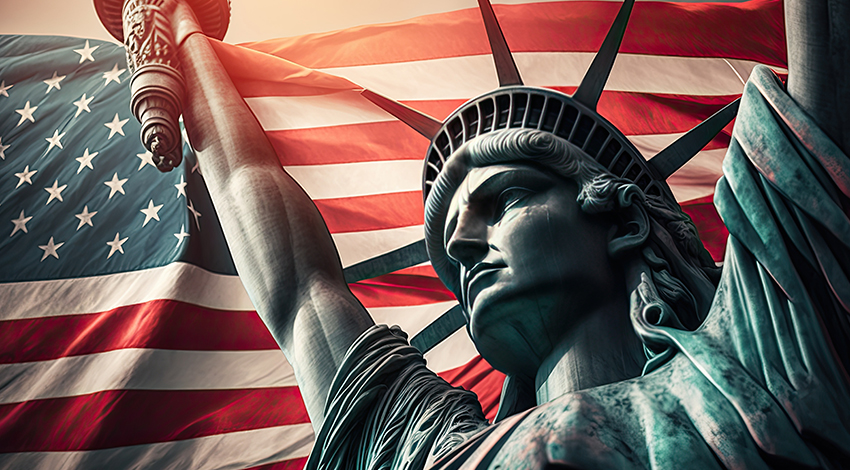The total value of exports and imports of goods and services equals 27.1% of GDP (gross domestic product). The average applied tariff rate is 2.6%, and there are more than 2,000 non-customs measures in effect. Protectionist policies created a great deal of uncertainty for companies, which increased the overall cost of trade and investment. The financial sector is one of the most developed in the world, and it is competitive and stable.
The United States, officially the United States of America, is a country in North America, a federal republic of 50 states. Along with the 48 neighbouring states that occupy the mid-latitudes of the continent, the United States includes Alaska, in the far northwest of North America, and the island state of Hawaii, in the mid-Pacific. The states are bordered on the north by Canada, on the east by the Atlantic Ocean, on the south by the Gulf of Mexico and Mexico, and on the west by the Pacific Ocean. The United States is the fourth largest country in the world by area (after Russia, Canada and China). The national capital is Washington, which is located close to the District of Columbia, and it is the Federal Capital Territory established in 1790.
The main feature of the United States is probably its great diversity. The physical environment of the United States ranges from arctic to semitropical, from humid rainforests to barren deserts, from rugged mountain tops to flat prairies. Although the total population of the United States is large according to worldwide standards, the overall population density is relatively low. The country embraces some of the world’s largest urban centers in addition to some of the most spacious areas that are almost free of residents or housing.
The United States contains a large number of residents. Unlike China, for instance, which is largely a home to indigineous people. The United States has such a diversity that largely came from massive, sustainable global immigration. There is probably no other country that has a wider range of racial, ethnic, and cultural types than the United States. In addition to the existence of the surviving Native Americans (including Native Americans, Aleuts, and Eskimos) and the descendants of Africans taken slaves to the New World. The national character has been constantly enriched, tested, and redefined by tens of millions of immigrants who generally came to America in hopes of reaching social, political, and economical oppurtinities bigger than the ones they had in the places from which they left. (It should be noted that although the terms “America” and “Americans” are used as synonyms for the United States and its citizens, respectively, they are also used in a broader sense for North, South and Central America collectively as citizens.)
The United States is the world’s greatest economic power, measured in terms of gross domestic product. The nation’s wealth reflects in part its rich natural resources and enormous agricultural crown, but it owes more to the country’s highly developed industry. Despite its relative economic self-sufficiency in many areas, the United States is the most important single factor in global trade by virtue of the sheer size of its economy. Its exports and imports represent major proportions of the world total. The United States also touches the global economy as a source and destination for investment capital. The country continues to maintain a more diverse economic life than any other life on earth, which provides the majority of its population one of the highest standards of living in the world.
The United States is a relatively young country by world standards, with an age less than 250 years; it achieved its current size only by mid-twentieth century. America was the first of the European colonies to successfully gain independence from its motherland, and it was the first country to be established in which the authority rests with its citizens, not the government. In the first century and a half, the country was mainly preoccupied with its regional expansion, economic growth, and social discussions that eventually led to a civil war and a recuperation period that is yet to be done. In the twentieth century, the United States appeared as a world power, and since WWII (Second World War), it has been one of the leading powers. It did not easily accept this cloak and had not always carry it voluntarily. The pronciples and ideals of its founders have been tested through the pressures and requisits of its dominant position. The United States still provides its residents with unmatched opportunities for personal development and wealth. Nevertheless, the depletion of its resources, environmental polution, and persistence of social and economical inequality that perpetuate areas of poverty and damage all threaten the wellbeing of the country.
The Territory of the United States of America
A lot of factors that define the physical environment of the United States are first, the geological factors, which determine the main patterns of terrain, the drainage system, and the mineral resources, and they affect the soil to a lesser extent. Second, the atmosphere, which not only dictate weather and climate, but also largely distribute kinds of soil, plants, and animals. Although, these factors are not completely independent of one another, each of them produces patterns on the map that differ so deeply that they remain essentially two separate geographic regions.
The center of the neighbouring United States is a large, sprawling inward lowland, stretching from the Old Shield of Central Canada in the north to the Gulf of Mexico in the south. To the east and west, these lowlands rise, first gradually then suddenly, into mountain ranges separating them from the sea on both sides. The mountanous system is radically different. The Appalachian Mountains in the east are low, almost unbroken, and located in the main region away from the Atlantic Ocean.
From New York to the Mexican border, the low-lying coastal plain, facing the ocean, stretches along a swampy, rolling coast. The gently sloping surface of the plain extends below the surface of the sea, forming the continental shelf, which, although submerged under shallow ocean waters, is geologically identical to the coastal plain. Southerly, the plain grows wider, swinging west into Georgia and Alabama to carve into the Appalachian Mountains along the southern side and separate the inward lowlands from the bay.
To the west of the central lowland lies the mighty Cordillera, which is part of the global mountain system that surrounds the Pacific Basin. The Cordillera includes a third of the entire United States, with an indoor variety to match its size. The Rocky Mountains lie on the country’s eatern marjin, and they are a high, varied, and discontinuous range that stretches all the way from New Mexico to the Canadian border. The western edge of the Cordillera is a Pacific coastal chain of rugged mountains and inland valleys, all of which rise spectacularly from the sea without taking advantage of the coastal plain. Between the Rocky Mountains and the Pacific Ocean is a huge complex of basins, plateaus, and isolated ranges between the Rocky Mountains and the Pacific Ocean, so large and picturesque that it deserves to be recognized as a separate region from the Cordillera itself.
These regions – the inner lowlands and their high ends, the Appalachian mountain system, the Atlantic Plain, the Western Cordillera, and the West Intermontan region – are so diverse that they require further division into 24 major sub-regions or provinces.
The United States Economy
The United States’ economic freedom score is 76.6, which makes its economy the 17th freest economy in the 2020 Index. Its overall score has decreased by 0.2 points mainly due to the decrease in the degree of freedom of trade. The United States ranks third out of 32 countries in the Americas region, and its overall scores are well above regional and global averages.
Economic freedom in America has declined over the past decade, mainly due to excessive government spending and overlapping regulation of the healthcare and financial sectors, although results have stabilized in recent years. GDP (Gross Domestic Product) growth has been doing well recently, too.
Deficit reckless spending by Congress and the administration under both parties explains the weakest indicators of the indicator: government spending and financial health. The approval of the recently renegotiated NAFTA agreement (now the agreement between the United States, Mexico, and Canada) should help ensure continued growth. Resolving the trade dispute between the United States and China could enhance trade freedom.
The United States has one of the world’s richest and most diverse economies. President Donald Trump sparked relatively strong economic growth by reducing ponderous regulations and signing a major tax reform bill into law, but deficit spending went unchecked. The administration’s protectionist trade policies will place an increased burden on economic growth if the newly applied tariffs are not reversed. The Democratic Party took control of the House of Representatives in January 2019, reducing the chances of passing major legislation affecting economic policy before the 2020 elections. Although services account for about 80 percent of Gross Domestic Product, the United States remains the second largest producer of manufactured goods in the world. And the leader in research and development.
Rules of Law
Private property rights are widely respected, but the federal government still owns about 28 percent of the total land. Contracts are effectively executed. The judiciary operates independently and is predictable, although the judicial appointments process is increasingly politicized. Corruption does not pose a major commercial threat, and the government is actively implementing an established anti-corruption legislative framework.
Governemt Size
The highest individual income tax rate is 37 percent, and the highest corporate tax rate is 21 percent. The total tax burden equals 27.1% of total domestic income. Government spending has reached 38.1 percent of the gross domestic product (GDP) over the past three years, and the average budget deficit is 4.0 percent of GDP. Public debt equals 105.8% of GDP.
Organizational Competence
Legal and political environments generally support entrepreneurial activity. Tax and regulatory reforms have pushed the unemployment rate to its lowest level in more than 50 years, with unemployment recorded among demographic minorities at its lowest. However, agricultural subsidies have been increased to compensate the effects of higher tariffs. While subsidies for health care, what is called “green energy”, and various forms of corporate welfare have continued.



